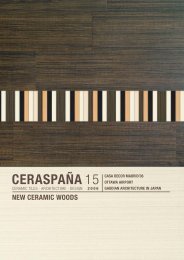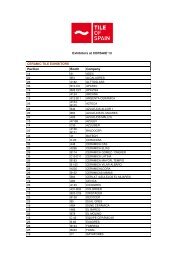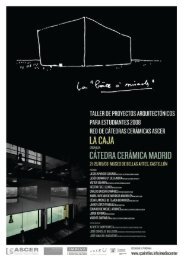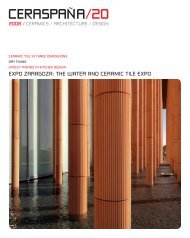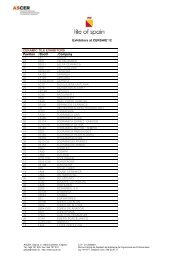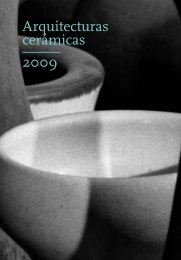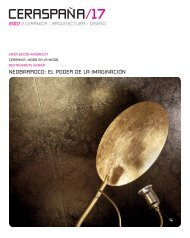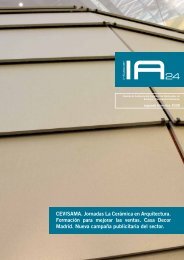showroom - Tile of Spain
showroom - Tile of Spain
showroom - Tile of Spain
- No tags were found...
Create successful ePaper yourself
Turn your PDF publications into a flip-book with our unique Google optimized e-Paper software.
Photograph <strong>of</strong> the spectacular Spanish Pavilion, covered with multi-coloured lattice tiles.The hexagonal ceramic tiles make up acomplex screen system. Alejandro Zaera alsodesigned the stainless steel structures andfixings, while the 15,000 ceramic tiles (11,000hollow and 4,000 flat) were designed byCerámica Decorativa and Toni Cumella. Thescreen uses a system or set <strong>of</strong> 14 tiles, sixdifferent hexagons each with theircorresponding mirror image– the wall has beenclad on both sides– plus two special pieces tomake the corners. The overall appearance <strong>of</strong>the wall is that <strong>of</strong> an irregular membrane, avisual effect that is heightened by the warmhues <strong>of</strong> the generous color palette that hasbeen used: two reds, selenium orange, yellow,salmon and dark brown.<strong>Spain</strong> and its sun, sand, wine and leather, etc., are the inspirationbehind the colours used for these lattice tiles.between the indoors and outdoors and filteringthe light to create a rich effect <strong>of</strong> lights andshadows.Cerámica Decorativa and Toni Cumelladevised a special production process for thesetiles, taking into account their complexity inorder to deliver the technical specificationsthe project demanded. Fourteen moulds hadto be made for the wet paste and the tiles hadto be fired twice. The first was a slow firing ina tunnel kiln to give the tiles the requiredstrength. Then, after the application <strong>of</strong> thesurface glaze by spray painting, the tiles weregiven a second firing in a muffle kiln, whichlasted 26 hours.Japan’s rigorous earthquake regulations meantthat Zaera and Mousavi had to leave a gap <strong>of</strong>one or two centimetres between each <strong>of</strong> thesides <strong>of</strong> the tiles. The requirement in factfavored the project as the gaps have given thefaçade an air <strong>of</strong> lightness. The space betweenthe screen and the solid inner structure acts asa kind <strong>of</strong> porch, blurring the boundariesThe end result is a pavilion that is undoubtedlyone <strong>of</strong> the most outstanding at this WorldExposition. The architect himself has suggestedthat when the exhibition closes, the tiles bedonated to nurseries in the city <strong>of</strong> Nagoya forthe children to play with or to the city’s parks,as sculptures, “so that some <strong>of</strong> the fabric <strong>of</strong><strong>Spain</strong> can become an integral part <strong>of</strong> Japan.”04CERASPAÑA



